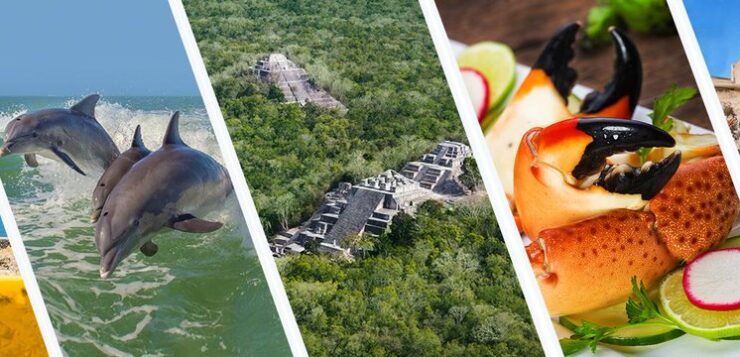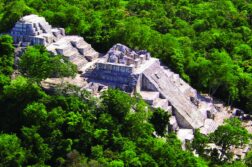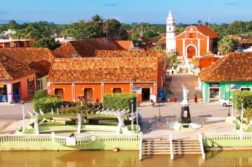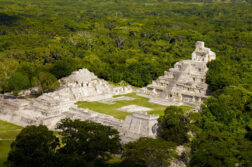Campeche (Spanish pronunciation: [kamˈpe.tʃe] (listen)), officially the Free and Sovereign State of Campeche (Spanish: Estado Libre y Soberano de Campeche), is one of the 32 states which make up the 32 Federal Entities of Mexico. Located in southeast Mexico, it is bordered by the states of Tabasco to the southwest, Yucatán to the northeast, and Quintana Roo to the east; to the southeast by the Orange Walk district of Belize, and by the Petén department of Guatemala to the south. It has a coastline to the west with the Gulf of Mexico. The state capital, also called Campeche, was declared a World Heritage Site in 1997. The formation of the state began with the city, which was founded in 1540 as the Spanish began the conquest of the Yucatán Peninsula. During the colonial period, the city was a rich and important port, but declined after Mexico’s independence. Campeche was part of the province of Yucatán but split off in the mid-19th century, mostly due to political friction with the city of Mérida. Much of the state’s recent economic revival is due to the finding of petroleum offshore in the 1970s, which has made the coastal cities of Campeche and Ciudad del Carmen important economic centers. The state has important Mayan and colonial sites; however, these are not as well-known or visited as others in the Yucatán.
The state’s executive power rests in the governor of Campeche and the legislative power rests in the Congress of Campeche which is a unicameral legislature composed of 35 deputies.
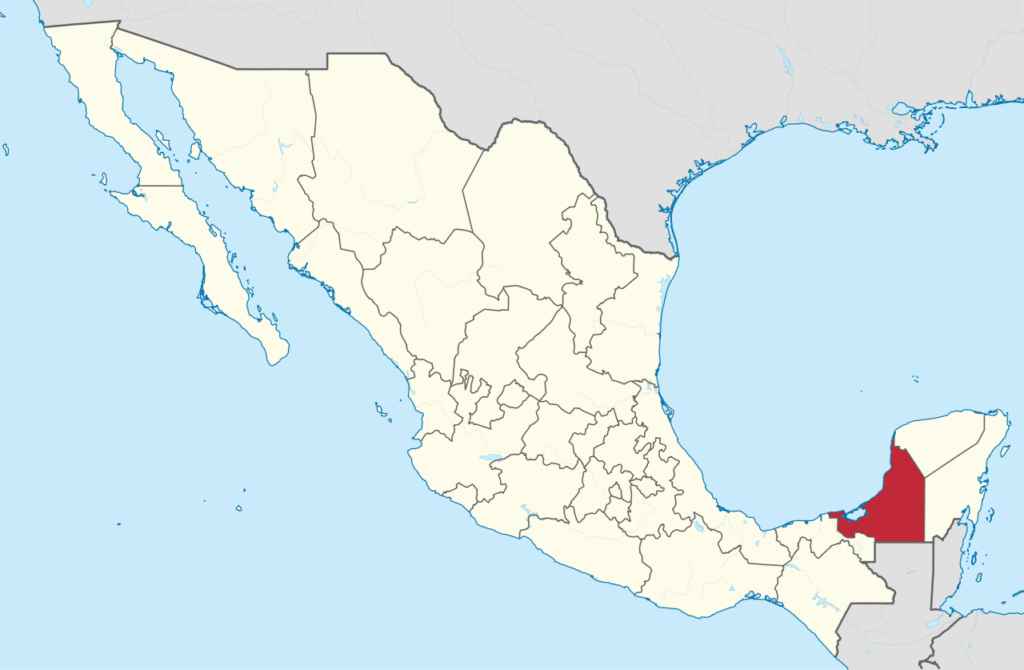
Geography and environment[edit]
The state of Campeche is located in southeast Mexico, on the west side of the Yucatan Peninsula. The territory is 56,858.84 square kilometres (21,953.32 sq mi), which is 2.6% of Mexico’s total. It borders the states of Yucatán, Quintana Roo and Tabasco, with the country of Belize to the east, Guatemala to the south and the Gulf of Mexico to the west. Politically, it is divided into eleven municipalities: Calkiní, Calakmul, Campeche, Candelaria, Champotón, Ciudad del Carmen, Escárcega, Hecelchakán, Hopelchén, Palizada and Tenabo.
Campeche is a relatively flat area of Mexico with 523 km (325 mi) of shoreline on the Gulf of Mexico. Most of the surface is of sedimentary rock much of which is from marine origin. The area with the highest elevations is near the borders with Guatemala and Quintana Roo. Notable elevations include Cerro Champerico, Cerro los Chinos, Cerro El Ramonal, Cerro El Doce, and Cerro El Gavilán. However, these hills are separated by large expanses of lower flat land. In the south of the municipality of Champotón begin a series of rolling hills known as the Sierra Alta or Puuc, which extend northeast to Bolonchen and then into the state of Yucatán. These have only an average altitude of between forty and sixty metres (130 and 200 ft) with some reaching 100 metres (330 ft). There other areas of these rolling hills, near the city of Campeche with main ones known as Maxtum, Boxol and El Morro. Another set is called the Sierra Seybaplaya in the center of the state.
Rainforest areas subdivide into a number of types which include perennial tall tree rainforest, semi perennial tall tree rainforest, deciduous medium height tree rainforest, semi deciduous medium height tree rainforest, deciduous low height tree rainforest and semi perennial low height tree rainforest. Away from the coast, these rainforests are interspersed with savannah areas and along the coast are accompanied by areas with sand dunes, mangrove wetlands and estuaries. Species that can be found in the various rainforests include huapaque, cedar (cedrela Mexicana), pukte (bucida buceras), sapote, dyewood (Haematoxylum campechianum), dzalam (lysiloma bohamensis) and more. It also includes a number of precious tropical hardwoods such as red cedar, mahogany, ciricote (cordia dodecandra) and guayacán (guialum sanctum). Along the coastal areas, palms dominate such as the coconut and royal palm. The main wildlife species in the state are the jaguar, ocelot, puma, deer, wild boar, raccoon, hare, ring-tailed cat and spider monkey. There are many bird species including the chachalaca, ducks, quail, pelican, toucan, buzzard and many more. Reptiles include rattlesnakes, coral snakes, boa constrictors, various species of sea and land turtles, iguanas and crocodiles. While still rich in wildlife, much has been decimated because of agriculture and exploitation of forest resources destroying habitat as well as uncontrolled hunting. Off the coast is most of the state aquatic life including many species of fish, crustaceans and mollusks. Many of these are exploited commercially.
Most of the state’s surface freshwater is in the south and southwest, with rivers, small lakes and estuaries. These diminish in the north where rainfall rapidly filtrates into the subsoil. The rivers in the south and southwest belong to various basins, with the largest being the Grijalva–Usumacinta to which the Candelaria, Chumpán and Mamantal Rivers belong. The Usumacinta also flows in the state but it tends to change course frequently and occasionally divides into branches. The east branch of this river is also called the Palizada River, which has the largest volume although it is narrow. The San Pedro River is another branch is the Usumacinta, which passes by the community of Jonuta in Tabasco before emptying in the Gulf. The Chumpán River is an isolated river formed by the union of various streams. It runs north-south and empties in the Laguna de Terminos. The Candelaria River forms in Petén, Guatemala and runs north-south and empties into the Laguna de Pargos. The Mamantel River empties into the Laguna de Panlau. The Champotón River is in the center of the state and empties into the Gulf. The rest of the states streams flow only in the rainy season.
The Laguna de Términos lagoon is located in the southwest of the state, near the Tabasco border. It is separated from the Gulf of Mexico only by the Isla del Carmen. It receives fresh water from most of Campeche’s rivers as well as salt water from the Gulf. In these brackish waters have developed a number of aquatic species such as sea bass, small sharks, crabs, oysters, turbles, and storks. The lagoon is ringed by smaller lakes and forms the most important lake-lagoon system in the country. These lakes include Atasta, Pom, Puerto Rico, El Este, Del Vapor, Del Corte, Pargos and Panlau. This system formed about five thousand years ago by the accumulation of sediment carried by surrounding rivers. This system connects to the Sabancuy estuary to the northeast.
Campeche is in the tropics; it has a humid climate, with a defined rainy season, and a relatively dry season from late winter to early spring. Average annual rainfall varies between 900 and 2,000 mm (35 and 79 in). The hottest and most humid areas of the state are along the coast between the Laguna de Términos and the northern border. Average annual temperature is 26 °C (79 °F) with highs up to 36 °C (97 °F) in the summer and lows of 17 °C (63 °F) in the winter. Prevailing winds are from the northwest from November to March, from the north between September and October, from the southeast from June to August and from the south in April and May. In the winter, storms from the north called “nortes” can bring colder dry air from the area of the United States. In the late summer, there are sometimes hurricanes.
The state has a number of ecosystems, from rainforest, to savanna to coast and sea. Environmentally, the state is divided into four major regions. The coast region consists of the entire coastline of the state and a strip of shallow water just offshore called the Sonda de Campeche with coral reefs and low islands called cays. The region has large expanses of mangroves which dominate the swamps. Non-swamp areas are dominated by palm trees. Wildlife is dominated by bird and reptile species such as storks, pelicans, ducks, seagulls, lizards, turtles and water snakes. The Mountain region is in the north and east of the state consisting of two chains of low hills called the Dzibalchen and Sierra Alta. It also includes the savannah area and an area called Los Chenes, where natural wells called cenotes are common. This area is noted for its tropical hardwoods and the chicle or gum tree. Wildlife includes deer, armadillos, rabbits, quail, and woodpeckers. The Rainforest region is located on the center and south of the state with a wide variety of trees including tropical hardwoods such as mahogany. Many of the plants used in the state’s cuisine such as achiote and tropical fruits are from here. This area is under threat due to over exploitation. The River region is located in the southwest of the state, named after the various rivers that flow here, mostly emptying into the Laguna de Términos. It has the hottest and most humid climate in Campeche with wildlife and vegetation similar to that found in both the Rainforest and Coast regions.
Campeche has three main protected areas: The Calakmul Biosphere Reserve, the Laguna de Términos Reserve and the Los Petenes Biosphere Reserve with total an area of 1,810,597 hectares (4,474,080 acres). The Calakmul Reserve was created in 1989 over 723,185 hectares (1,787,030 acres). It consists of Yucatán and Tehuantepec moist forests, containing high and medium growth semi-deciduous forests and seasonally flooded low height semi-deciduous forests. There is also aquatic vegetation. The Laguna de Términos Reserve includes the lagoon and the area surrounding it with an area of 705,017 hectares (1,742,130 acres). It was established in 1994. Los Petenes is a natural reserve consisting of isolated pockets of rainforest with mangrove areas in between. The wildlife is dependent on a varied and complex system of fresh and brackish water. The reserve extends over 382 hectares (940 acres) in the municipalities of Campeche, Tenabo, Hecelchakan and Calkini.


